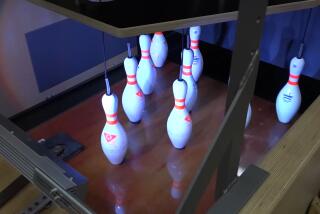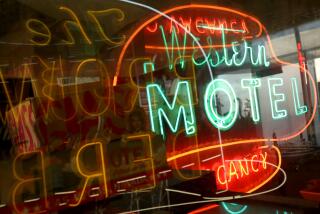Full-Tilt Frenzy Forever
- Share via
In the late 1970s, while his peers were out surfing, Patrick “P.J.” Sheehy was following a pinball machine mechanic around the El Dorado Bowl on Lincoln Boulevard near LAX. “I’d go meet him, even if it meant ditching class,” Sheehy says. “I idolized those guys more than any pro baseball player.” Sheehy was so transfixed with the machines that he wrote to local pinball distributors offering to sweep floors, clean up--anything--to be near the bumpers, flippers, bells and spectacularly painted “back-glass” designs. In those days, he was usually told (in effect) to get lost.
After finishing school, Sheehy fixed VCRs and copiers before moving on to pinball and jukebox repair. Now the established specialist gets calls at all hours from the same distributors who once ignored him. “It’s taken me nine years of 24/7 work,” he says. Along the way, Sheehy, 37, says he has fixed Arnold Schwarzenegger’s pinball machine and performed jukebox repair for Quentin Tarantino and Tom Hanks.
Sheehy acquired more than 125 pinball machines before realizing that he was running out of room. This summer he created P.J.’s Pinball Museum, which displays more than 50 working machines in his Culver City storefront space. “You can live it all over again,” he says. “It’s like falling in love, but it never ends.” The oldest machine on view is a 1952 wood machine called Key West. “They’re my children,” he says. “This is your own personal Disneyland on a 3-by-4-foot table. It’s a comic book come alive.”
It’s also a pop culture history lesson. “The artwork on ‘Mata Hari’ was too suggestive,” says Sheehy. “It made church women go bananas. They were calling pinball machines pornography.” He also displays “Nip It,” a machine created in the 1970s but featured mistakenly, he says, on TV’s ‘50s-themed “Happy Days” sitcom. Many machines, such as “Six Million Dollar Man,” “Star Trek” and a “Playboy” game, anticipate the era of the licensing tie-in. The images of Roger Daltrey and Ann-Margret appear on “Wizard,” a homage to the Ken Russell film based on the Who’s rock opera “Tommy,” which featured the hit song “Pinball Wizard.”
Games in which players use sticks to land balls in holes have been around for centuries; early pinball machines such as the Ballyhoo began appearing in the early 1930s, and the game went electric in the same decade. Classic features such as bumpers and flippers appear during the ‘40s. Pinball ruled the arcades between the late ‘70s and early ‘80s, he says, but business dwindled with the advent of video games. “They moved away from bells in 1978 and went to electric sounds,” says Sheehy, who plays but appreciates the machines primarily for their artistic design. “Now [pinball] is Americana.”
Future museum exhibits include Johnny Six Shooter, a life-sized outlaw mannequin that Sheehy acquired with other animatronic displays when Disneyland and Knott’s Berry Farm got rid of some of their gun games. He also hopes to form an appreciation society for special events. As adolescent thrills go, Sheehy is still racking up the bonus points. “Guys my age, we’ll go to our graves lovin’ this.”
*
P.J.’s Pinball Museum, 4350 Sepulveda Blvd., Culver City, (310) 391-2969
More to Read
The biggest entertainment stories
Get our big stories about Hollywood, film, television, music, arts, culture and more right in your inbox as soon as they publish.
You may occasionally receive promotional content from the Los Angeles Times.










